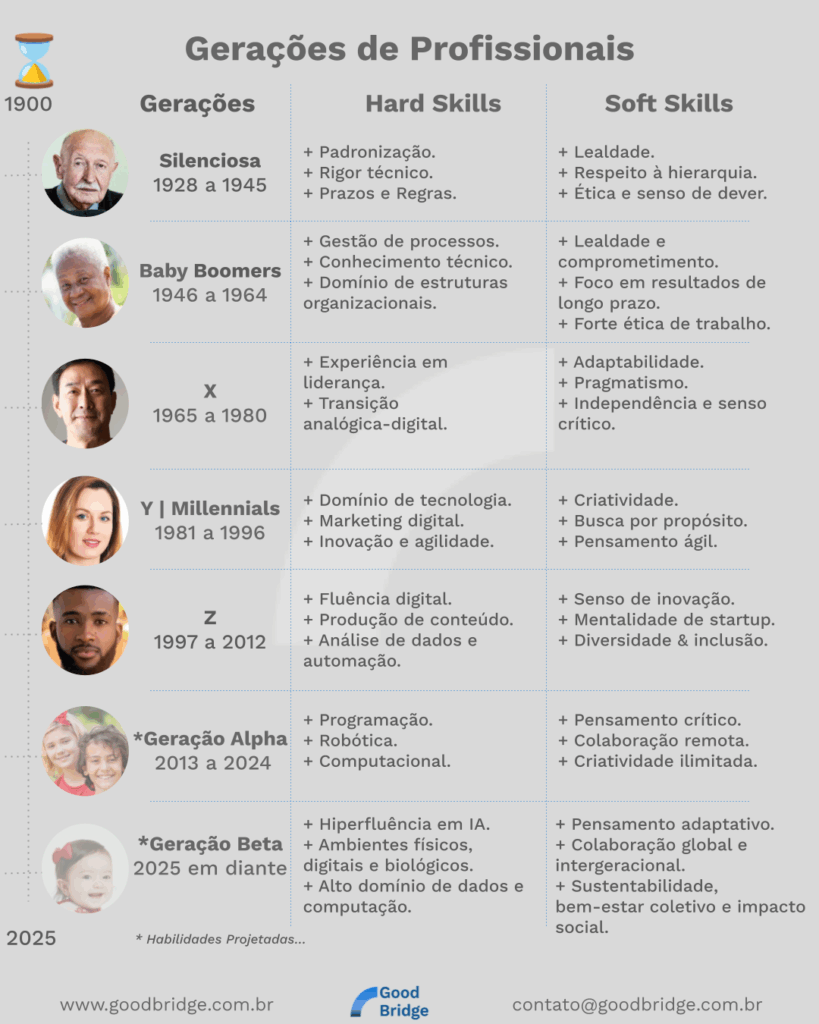Have you ever stopped to think about how valuable it is to have different generations working together? Each generation brings with it experiences, skills and worldviews that, when well combined, can be the competitive edge of a business.
Below, we will present where the concept originated, the main active professional generations; with their respective birth periods, characteristics and the skills that stand out most in each one. In the end, you will understand how mixing them can boost your team's results!
📍 Where did the concept of Generations originate?
The concept of professional generations is often associated with the work of William Strauss (writer and playwright) and Neil Howe (historian) in the 1991 book "Generations". Although the discussion about generations has older roots in areas such as social sciences, Strauss and Howe popularized the idea that groups of people born in specific times tend to exhibit similar behaviors and values.
👴🏼 Silent Generation (1928 to 1945).
Why this name?
The term “Silent Generation” was coined by scholars in the 1950s to describe a group of people who grew up in difficult times, such as the Great Depression and World War II, and who therefore valued stability, discretion, and respect for authority. In general, they avoided confrontation and maintained a more reserved and institutional profile.
Professional contributions (most notable skills):
Hard Skills:
- Discipline and standardization of processes.
- Technical and methodological rigor.
- High responsibility with deadlines and rules.
Soft Skills:
- Loyalty and commitment.
- Respect for hierarchy and organizational culture.
- Ethics and sense of duty.
🧓🏽 Baby Boomers (1946 to 1964).
Why this name?
The term “Baby Boomers” arose due to the “baby boom,” the explosion of births after World War II. This generation grew up in a period of economic optimism, stability, and appreciation for hard work.
Professional contributions (most notable skills):
Hard skills:
- Process management.
- Deep technical knowledge.
- Mastery of traditional organizational structures.
Soft skills:
- Loyalty and commitment.
- Focus on long-term results.
- Strong work ethic.
👔 Generation X (1965 to 1980).
Why this name?
The “X” symbolizes uncertainty. This generation grew up amid social changes, economic crises, and the beginning of globalization. They were the first to balance the analog world with the digital one.
Professional contributions (most notable skills):
Hard skills:
- Strategic thinking.
- Leadership experience.
- Analog-to-digital transition.
Soft skills:
- Adaptability.
- Pragmatism.
- Independence and critical thinking.
💻 Generation Y / Millennials (1981 to 1996).
Why this name?
Generation Y came after X, and is also known as Millennials because they reached adulthood around the year 2000. They were the first digital natives and grew up amidst the internet, social networks and intense globalization.
Professional contributions (most notable skills):
Hard skills:
- Mastery of technology.
- Digital marketing.
- Innovation and agility.
Soft skills:
- Creativity.
- Search for purpose.
- Agile thinking.
📱 Generation Z (1997 to 2012).
Why this name?
The “Z” represents the alphabetical sequence of generations. They grew up fully connected and are true tech natives. Many of them are now entering the job market, with a more disruptive and digitalized vision.
Professional contributions (most notable skills):
Hard skills:
- Digital fluency.
- Content production.
- Data analysis and automation.
Soft skills:
- Sense of innovation.
- Startup mentality.
- Diversity & inclusion.
🤖 Generation Alpha (2013 to 2024).
Why this name?
Alpha marks the restart of the Greek alphabet. These are children who are growing up in a 100% digital world, with artificial intelligence, augmented reality and technology-based learning from the earliest years.
Professional contributions (Projected…):
Hard skills (in development):
- Programming.
- Robotics.
- Computational thinking.
Soft skills (in development):
- Critical thinking.
- Remote collaboration.
- Unlimited creativity.
🌐 Beta Generation (from 2025 onwards).
Why this name?
The name "Beta Generation" represents an era marked by even more accelerated transformations, where the physical and digital worlds will be fully integrated. The letter "Beta" refers to the concept of continuous evolution, adaptation and constant innovation, very common in software development and which is increasingly becoming part of human life itself.
This generation will be born into a context of ubiquitous artificial intelligence, advances in biotechnology, quantum computing, metaverse and radical sustainability, growing up in a world that no longer distinguishes between online and offline.
This generation will arrive in a market that will probably be less about "working" and more about "solving problems" and "creating collective value", with flexible, decentralized and highly collaborative models.
Professional contributions (Projected…):
Hard Skills (expected):
- Hyperfluency in artificial intelligence and mixed reality.
- Ability to operate in physical, digital and biological environments (bioengineering, neurotechnology).
- High mastery of data and advanced computing.
Soft Skills (expected):
- Extreme adaptive thinking.
- Capacity for global, intercultural and intergenerational collaboration.
- Complex problem-solving with a focus on sustainability, collective well-being and social impact.
🔄 The strength of the Blend: The Power of Multigenerational Teams.
Now that you know the potential of each generation, we can answer the question: why should your company invest in intergenerational teams?
- Innovation with experience: Young people bring disruptive ideas, while the more experienced help to put them into practice with wisdom and risk-taking.
- Continuous learning: Reverse mentoring between generations increases mutual learning and breaks down cultural barriers.
- More inclusive environment: Multigenerational teams promote respect, empathy and exchange of values.
- Better decision-making: Age diversity broadens strategic vision, bringing multiple perspectives to business challenges.
- Engagement and retention: Each generation has its own motivations. By understanding and integrating them, your company increases engagement and reduces turnover.
🚀 Conclusion
Understanding the value of different generations is an essential step to building stronger, more creative and resilient teams.
Bet on the mix. Intergenerational teams are not just a trend — they are a strategy.
If this content made sense to you, share it with your network and tag that colleague who still thinks that “age is a problem”.
Let's transform diversity into a competitive advantage together!
Team Good Bridge.
